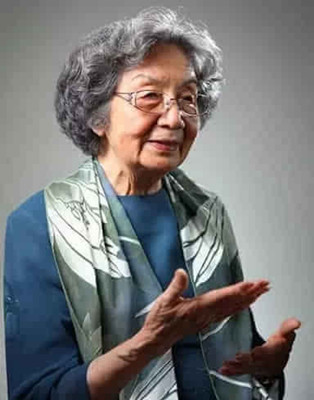Intonation unique aspect of Chinese literary culture
Author : Hua Feng Source : Chinese Social Sciences Today 2016-03-17

Florence Chia-ying Yeh (1924- ), also known as Ye Jiaying (married name Chia-ying Yeh Chao), is a Canadian Chinese classical literary expert and professor emeritus at the University of British Columbia. After her retirement, she served as director and doctoral supervisor of the Institute of Chinese Classical Culture at Nankai University in Tianjin, and honorary research fellow of the Institute of Literature at the Chinese Academy of Social Sciences.
Intonation is a traditional reading method in China. It refers to a reading method with rich emotions, following a certain rhyme and rhythm. In modern times, intonation gradually declined in popularity, but since the 1980s, intonation has seen resurgence and developed rapidly. However, it has been mixed with some other aspects. Some scholars combined intonation with singing, operas and Western music, even going so far as to create so-called “self-composed” new melodies, and claimed this was “authentic” intonation, which obscured the meaning of traditional intonation.
The intonation education Yeh received in her youth is regarded as the most complete and comprehensive form of traditional intonation education in China. This period of education laid a solid foundation for her studies at college. At college, she was taught by famous experts in intonation and improved her understanding of classical Chinese poetry through intonation. The dynamic integration of family education and college teaching has endowed Yeh’s intonation with both the beauty of traditional intonation and deep consciousness of the academic situation.
Yeh said that intonation is a unique and valuable form of traditional Chinese culture. She elaborates: “Rationally speaking, I feel more and more strongly that intonation has a direct connection with the traditions of Chinese culture. The influence it exerted on Chinese culture is subtle but extremely important, and we cannot cut off this generation’s relationship with intonation.”
“The intonation we’re talking about today only exists in China,” she added. During Chinese Intonation Week in Beijing in 2009, Yeh said that elementary and secondary schools should open intonation classes, and even in kindergarten, children should be taught how to intonate. Her proposal obviously shows her profound consideration of the issue, which is visionary. Yeh has already realized the significant relationship between intonation and the inheritance of traditional Chinese culture. Her view that “the tradition of intonation only exists in China” is very insightful. Previously, many foreign Sinologists could still intonate accurately. For instance, Japanese scholar Kōjirō Yoshikawa (1904-80) could intonate Ascending a Height, a poem of Du Fu (712-770) in the Tang Dynasty (618-907) in an authentic tone. However, more and more modern foreign scholars’ intonation has gradually become localized, which is completely different from traditional Chinese intonation. So what Yeh indicated is quite clear: The authentic roots of intonation are in China.
Yeh regards intonation as a reading method and never treats it as some complicated or mysterious thing. She pinpointed the key issue accurately: “Whether or not one can intonate accurately or well firstly depends on the rhythm of voice, and the tempo and level of rhythm. Actually, it is not a very complicated thing to master such rules. As long as learners can listen to many examples of intonation, they can become naturally familiar with tones and rhythms.” Ancient people never took intonation as some difficult form of knowledge and instead just regarded it as a natural reading method.
The relationship between tone and rhythm touches upon the essential part of intonation. In fact, today we learn intonation and promote it. There are three significant factors we should keep in mind, that is, the combination of tone, rhythm and intonation’s content. Yeh emphasizes that teaching students to learn intonation should first involve following some simple melodies with various changing tones. It is a very reasonable arrangement for students. “Although we can keep our different accents when we intonate, we must master the vocal range of the rhythm and tone, and make them echo with each other between the lines.”
Moreover, she puts a key emphasis on understanding poems’ content when people intonate. Utilizing the intonation method to read can help people better understand ancient poets’ works, which constitutes the key part of Yeh’s intonation concepts. She always makes a detailed analysis on what she reads and then intonates. Most ordinary people only listen to intonation. Yeh’s view on intonation is to interpret poems’ content. Her explanation of poems in return helps people to understand intonation, so the two supplement each other and become a form of dynamic integration.
The formation of Chinese poetry, especially the formation of Chinese metrical poetry, is closely connected with intonation. The birth of Chinese metrical poetry conforms to the demands of intonation. Accordingly, intonation also promotes the development of Chinese poetry, especially Chinese metrical poetry. Yeh’s understanding of intonation demonstrates the close relationship between intonation and Chinese classical poetry.
Hua Feng is from the College of Chinese Language and Literature at Henan University.
Ye Shengtao made Chinese fairy tales from a wilderness
Ye Shengtao (1894–1988) created the first collection of fairy tales in the history of Chinese children’s literature...
-
How northern ethnicities integrated into Chinese nation
2023-09-18
-
Mogao caves
2023-09-12
-
Mogao Grottoes as ‘a place of pilgrimage’
2023-09-12
-
Time-honored architectural traditions in China
2023-08-29
-
Disentangling the civilizational evolution of China
2023-08-28
-
AI ethics in science fiction
2023-08-23














 2011-2013 by www.cssn.cn. All Rights Reserved
2011-2013 by www.cssn.cn. All Rights Reserved